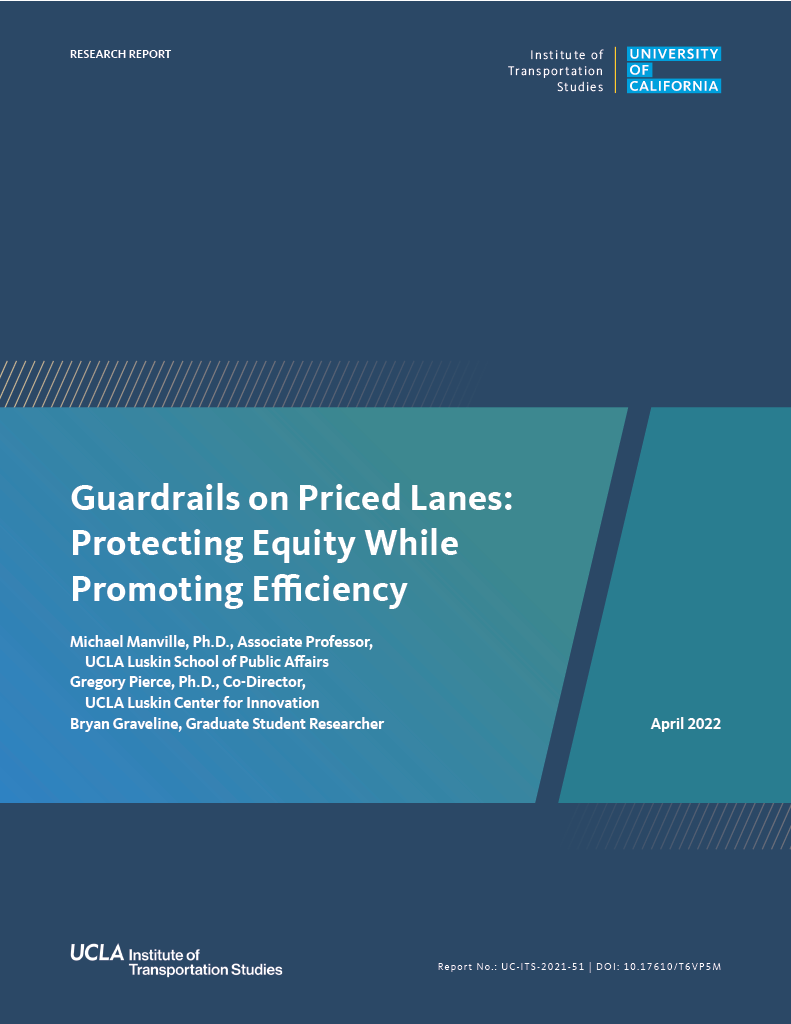Project ID:
LA2011Year Completed:
2022Funding Source:
Statewide Transportation Research ProgramProject Description
Congestion pricing in its various forms is the most promising tool that planners and policymakers have for combatting congestion, and the various ancillary problems—like crashes and pollution—that congestion helps cause. But pricing is met with caution by people concerned about fairness. On the surface, pricing seems like a perfect illustration of the tension between efficiency and equity. Traffic congestion is an inefficiency. Roads get congested because they are underpriced—free to use even when demand is high. Congestion tolls work by charging more for roads in times and places where more people want to use them—more at 8 a.m. than 8 p.m., more on Monday than Sunday, more on urban freeways than the urban fringe. When governments have used them, prices have helped roads flow freely. They have also helped reduce pollution, crashes, and greenhouse gas (GHG) emissions.
Merely suggesting prices, however, raises understandable concerns about fairness. People need cars. Some people, already burdened by high housing prices, are driving many miles every day—how would tolling the roads affect them? Transit in many places is inadequate for many trips. Low-income drivers risk being severely burdened if roads are tolled. And because people of color are disproportionately represented among people of low income, tolls risk becoming a regressive burden that is uneven along racial lines.
Can we get the benefits of congestion pricing while avoiding these equity costs? Our research proposal aims to outline strategies for doing just that. In so doing it answers the call for “research activity that examines the opportunities and barriers of various congestion pricing strategies that have the potential to equitably reduce vehicle miles traveled.” Our project combines solid empirics with a wealth of information drawn from programs already operating in California which are designed to make basic services comparable to travel affordable. We will use empirical data on vehicle ownership and travel, on the distribution of population around congested corridors, and on existing equity programs in other utility sectors. We will combine these with lessons from redistribution policies in other comparable infrastructure sectors (eg, water, electricity, natural gas) aimed to both limit total consumption of the service (similar to the overall goal of congestion pricing) and make a baseline amount of the service affordable for all. The combination of these two approaches will yield a rigorous and data-informed conceptual model for designing pricing programs that protect vulnerable populations.
The project’s ultimate goal is threefold. First, we will deliver a broad but accurate and relevant snapshot of vulnerable travelers in California. Second, we will use that information to carefully consider how different forms of congestion pricing might improve or degrade equity. Third and most important, we will use lessons from other safety-net programs, and particularly those operating in the utility industry in California, to propose specific safeguards for poor and marginalized populations that can be built into congestion charging programs.
Publications

Michael Manville (PI)
mmanvill@ucla.edu
Research Team
Program Area(s):


